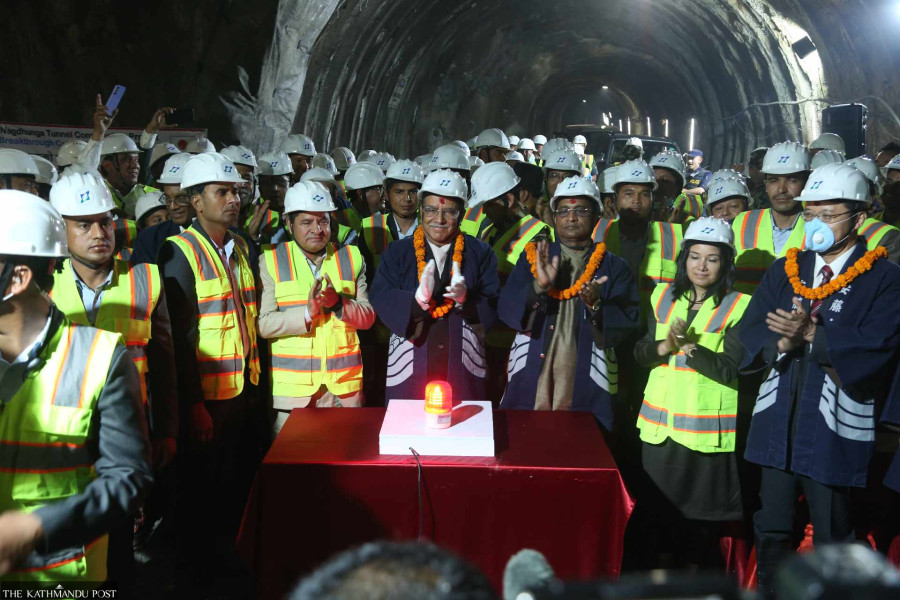National
Nagdhunga-Sisnekhola tunnel road makes final breakthrough
Prime Minister Pushpa Kamal Dahal says the tunnel is an important infrastructural achievement for Nepal.
Post Report
The Nagdhunga-Sisnekhola tunnel made its final breakthrough on Monday.
The breakthrough was completed after explosives were detonated to clear out the final two-metre stretch of the main tunnel. The passageway will open to the public in about a year.
Speaking at the event organised on the occasion, Prime Minister Pushpa Kamal Dahal said that the completion of the tunnel was an important infrastructural achievement for Nepal and that it would help realise the national goals of development and road expansion.
“Taking this tunnel as a reference, we will prepare reports on tunnels suitable for the Nepali soil,” Dahal said. “This [tunnel] will help Nepal enter the ‘tunnel age’.”
Dahal said he believes the passageway would help ease traffic, prevent major road accidents and act as a solution to natural disasters such as landslides during the monsoon season.

The Nagdhunga-Sisnekhola tunnel runs between Dhading, where the lower end of the tunnel is located, and Nagdhunga in Kathmandu, the higher part.
With the project’s completion, commuters on the Nagdhunga-Naubise stretch will be able to avoid at least 19 hairpin bends and sharp curves along an 8 km section of the roadway.
According to a 2015 preparatory survey, it takes around 34 minutes to navigate the 8 km section following the route’s existing alignment.
In 2016, the Japanese government had agreed to provide a soft loan of Rs15.28 billion to build the tunnel to eliminate the need to travel the circuitous route over the Valley’s western rim, which is the main overland link between the Capital and the southern plains.
Constructed by the Japanese company Hazama-Ando Corporation, the 2.68-kilometre-long tunnel passes under the western rim of the Kathmandu Valley, allowing motorists to avoid the treacherous hills which face frequent landslides.

The then Prime Minister KP Sharma Oli laid the foundation stone of the Rs22 billion project in October 2019.
The project was supposed to be completed in three-and-a-half years from the date of implementation. But it was delayed due to the Covid pandemic followed by a shortage of construction materials a few months ago.
Initially, the project faced delays due to problems with the acquisition of 44 ropanis of land in Dhading for the project office because of differences between the project and locals of Dhunibesi in Dhading over the compensation rate and lack of clarity over acquiring trust lands and unregistered land.
The Home Ministry’s January 4, 2023 circular to ban “illegal” crusher plants across the country had also affected the project for a month.
The deadline of the project, which was first extended by three months, was then extended to April 25 of this year, from its original deadline of April 26, 2023.

Besides the tunnel from Sisne Khola to Basnetchhap, the project also has a 2.6 km four-lane approach road with a service lane on each side.
Of the total, 2.2 kilometres of the approach road will extend from Basnetchhap to Thankot and the rest on the other side of the tunnel.
The approach road will have three bridges, toll booths and a roadside rest area for travellers.
The rest area, spread over 4,650 square metres, will have fast food restaurants, shops, toilets and a parking space for nine heavy vehicles and 23 light ones.




 5.14°C Kathmandu
5.14°C Kathmandu







%20(1).jpg&w=300&height=200)





